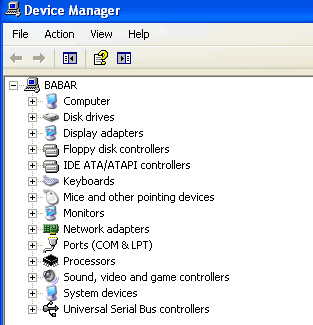Disabling unneeded hardware devices
Every time you turn on your computer, it has to load and initialize all of your computer hardware. Keep in mind: Your computer has a lot of devices that you do not always use. These extra devices are loaded and initialized during every boot.When it does so, your computer's performance is slowed down.
Windows XP is now a lot more efficient and smarter during the boot-up cycle. In previous versions of Windows, the system would load one hardware device driver and then load another device driver in a series. The only problem with loading the hardware this way was that it could slow down the boot dramatically if one hardware device was taking a long time to initialize. One well-known culprit of this is the network card which pauses to wait to get an IP from a DHCP server.
Windows XP has a new way of initializing the hardware devices when the system boots up. Instead of loading the hardware device drivers in series, it now loads some of them in parallel. This allows the boot to be much faster. Although the hardware devices are loaded in parallel instead of series, the addition of more devices that the system has to load drivers for will probably still slow down the boot.
To disable hardware devices, you will want to use the Device Manager. Figure shows the Device Manager and all of the different categories of devices.To get to the Device Manager, do the following:

- Go to the Control Panel using the shortcut on the Start panel or menu if you are using the classic Windows interface.
- Once you are in Control Panel, locate the System icon and run it. If you cannot find the System icon, most likely you are using the Control Panel Category View. If you are using the Category View, click the Performance and Maintenance icon and then you will see the System icon under the "or pick a Control Panel icon" heading.
- Once the System Properties window has loaded, click the Hardware tab. Under the Device Manager section, click the button that says Device Manager.
- Now that you are inside of the Device Manager, you can browse through your devices that are connected and currently running or disabled by browsing through the device type sections.To disable a device, right-click the device name, and then select Disable.
- To re-enable a device, right-click the device name, and select Disable. This will remove the check from the menu and will re-enable the device.
To quickly determine the status of a device, check out the icon next to its name. All devices that are disabled have a red X over the icon. All devices that have a question mark or an explanation point on them are not set up correctly or are having problems. All devices with none of the above additions to the icon are running and doing so without any problems.
What hardware devices should disable?
Each user uses (or does not use) devices differently, depending on the system setup. Nonetheless, some classes of devices are more commonly disabled than others. Knowing which ones will help you make a decision as to what devices you should disable. The following classes of devices are frequently disabled:
Network Adapters:
Especially on Notebook computers, there are often more than one network device. Disabling the network devices that you do not use will definitely save you some booting time.
Fire wire:
If you have 1394 connections, otherwise known as fire wire, you might consider disabling them. Unless you are using your fire wire port to connect your digital video recorder to your computer, or have other external fire wire devices, you have no need to have this device enabled.
Modems:
Do you have a broadband connection? If so, then consider disabling your modem. If you rarely use it, disable it. If you ever need to use it again, just re-enable it.
Multimedia devices:
Your computer has lots of multimedia devices.Take a look at the "Sound, video, and game controllers" section in Device Manager. You will find a lot of device drivers that are loaded during your boot. Some are used by all users, but others will find a few that they do not use.
PCMCIA:
If you are a laptop user, consider disabling your PCMCIA card controller, located under "PCMCIA adapters." The PCMCIA (Personal Computer Memory Card International Association ) slot is a special expansion slot that is rarely used today on laptops except for wireless and wired network cards and card reader attachments for compact flash and other solid state memory cards. Most laptops now have built-in network adapters and some even have built-in wireless adapters. If you do not use your PCMCIA adapter, it is yet another device that can be safely disabled.
Do not disable any hardware devices that are located under the Disk Drives, Computer, Display Adapters, IDE Disk Controllers, and the System sections (except for the system speaker) because these hardware devices are critical to the operation of your computer.
